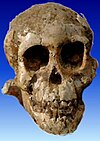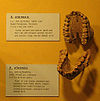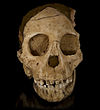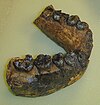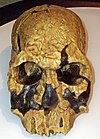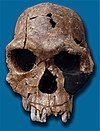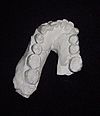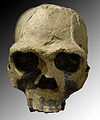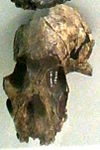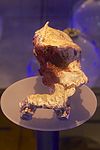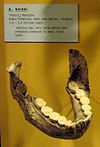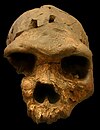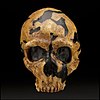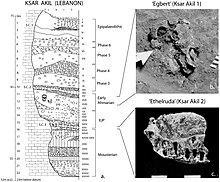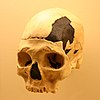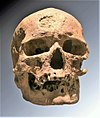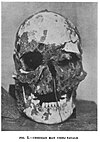Liste de fossiles d'hominidés

Cette liste de fossiles d'hominidés présente un certain nombre de fossiles d'hominines selon un classement chronologique. Il existe des milliers de fossiles, dont beaucoup sont fragmentaires et ne consistent qu'en de simples dents ou fragments d'os isolés. Cette liste ne se veut pas exhaustive, mais présente les principaux spécimens découverts[1]. La plupart de ces fossiles se situent sur des branches ou des rameaux distincts de la branche hypothétique menant à Homo sapiens.
Les découvertes de fossiles en Afrique du Sud, le long de la grande faille est-africaine, et au Tchad, s'expliquent en partie par un biais géologique et taphonomique. En effet, dans de nombreuses régions d'Afrique, la faible activité tectonique, la moindre sédimentation, le couvert forestier actuel qui donne des sols acides, et d'autres facteurs, en ont empêché la fossilisation, la conservation, ou la mise au jour[2].
Fin du Miocène[modifier | modifier le code]
- De 7 à 5,33 millions d'années
| Nom | Âge | Espèce | Année de découverte |
Lieu | Découvreur | |
|---|---|---|---|---|---|---|

|
TM 266-01-060-01 (Toumaï)[3] |
7 Ma | Sahelanthropus tchadensis (holotype) |
2001 | Toros-Menalla, Tchad |
Alain Beauvilain, Fanone Gongdibe, Mahamat Adoum, et Ahounta Djimdoumalbaye (équipe de Michel Brunet) |
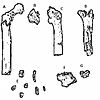
|
BAR 1000'00[4] | 5,9 Ma | Orrorin tugenensis (holotype) |
2000 | Collines Tugen, District de Baringo, Kenya |
Brigitte Senut, Martin Pickford, Kiptalam Cheboi, Dominique Gommery, et Pierre Mein |
| Empreintes de pas de Trachilos | 5,7 Ma | Homininé ou primate inconnu | 2002 | Grèce | Gerard D. Gierliński | |

|
ALA-VP-2/10[5] | 5,5 - 5,8 Ma | Ardipithecus kadabba (holotype) |
1999 | Alayla, Moyen-Awash, Afar, Éthiopie |
Yohannes Haile-Selassie |
Pliocène[modifier | modifier le code]
- De 5,33 à 2,58 millions d'années
Pléistocène inférieur[modifier | modifier le code]
- De 2,58 millions à 781 000 ans
Pléistocène moyen et supérieur[modifier | modifier le code]
Paléolithique inférieur[modifier | modifier le code]
- De 781 000 à 350 000 ans
Paléolithique moyen[modifier | modifier le code]
- De 350 000 à 45 000 ans
Paléolithique supérieur[modifier | modifier le code]
- De 45 000 à 11 700 ans avant le présent (AP)
Holocène[modifier | modifier le code]
- Moins de 11 700 ans avant le présent (AP)
Glossaire[modifier | modifier le code]

Voici une liste de termes fréquemment utilisés dans les ouvrages listant les fossiles d'hominidés :
- AL - Afar Locality, Éthiopie
- ARA-VP - Aramis Vertebrate Paleontology, Éthiopie
- BAR - (Lukeino, Tugen Hills (en)) district de Baringo (en), Kenya
- BOU-VP - Bouri Vertebrate Paleontology, Éthiopie
- D - Dmanissi, Géorgie
- ER - East Rudolf, Kenya
- KGA - Konso-Gardula, Éthiopie
- KNM - Kenya National Museum, Kenya
- KP - Kanapoi, Kenya
- LB - Liang Bua, Indonésie
- LH - Laetoli Hominid, Tanzanie
- NG - Ngandong, Indonésie
- OH - Olduvai Hominid, Tanzanie
- SK - Swartkrans, Afrique du Sud
- Sts, Stw - Sterkfontein, Afrique du Sud
- TM - Transvaal Museum, Afrique du Sud
- TM - Toros-Menalla, Tchad
- WT - West Turkana, Kenya
Notes et références[modifier | modifier le code]
- (en) « Prominent Hominid Fossils ».
- Joseph Ki-Zerbo, Méthodologie et préhistoire africaine, UNESCO, , p. 527
- (en) Michel Brunet et al., « A new hominid from the Upper Miocene of Chad, Central Africa », Nature, vol. 418, , p. 145-151 (DOI 10.1038/nature00879)
- (en) Brigitte Senut, Martin Pickford et al., « First hominid from the Miocene (Lukeino Formation, Kenya) », Comptes Rendus de l'Académie des Sciences, vol. 332, no 2, , p. 137-144 (DOI 10.1016/S1251-8050(01)01529-4)
- (en) Bernard Wood, Wiley-Blackwell Encyclopedia of Human Evolution, Wiley-Blackwell, , 1056 p. (ISBN 978-1-118-65099-8, DOI 10.1002/9781444342499)
- (en) Marc Kissel et John Hawks, « What are the Lothagam and Tabarin Mandibles ? », PaleoAnthropology, , p. 37–43, lire en ligne
- (en) Timothy D. White, Gen Suwa et Berhane Asfaw, « Australopithecus ramidus, a new species of early hominid from Aramis, Ethiopia », Nature, vol. 371, , p. 306-312 (DOI 10.1038/371306a0)
- (en) Jonathan Amos, « Fossil finds extend human story », BBC News, .
- (en) Andrew Hill et Steven Ward, « Origin of the Hominidae : The Record of African Large Hominoid Evolution Between 14 My and 4 My », Yearbook of Physical Anthropology, vol. 31, no 59, , p. 49–83 (DOI 10.1002/ajpa.1330310505)
- (en) Darryl E. Granger, Ryan J. Gibbon, Kathleen Kuman, Ronald J. Clarke, Laurent Bruxelles et Marc W. Caffee, « New cosmogenic burial ages for Sterkfontein Member 2 Australopithecus and Member 5 Oldowan », Nature, (DOI 10.1038/nature14268)
- (en) Michel Brunet et al., « The first australopithecine 2,500 kilometres west of the Rift Valley (Chad) », Nature, vol. 378, , p. 273-2751 (DOI 10.1038/378273a0)
- (en) John Reader, Missing Links : In Search of Human Origin, OUP Oxford, , 538 p. (lire en ligne), p. 365-372
- (en) Yohannes Haile-Selassie et al., « An early Australopithecus afarensis postcranium from Woranso-Mille, Ethiopia », PNAS, vol. 107, no 27, , p. 12121–12126 (DOI 10.1073/pnas.1004527107)
- (en) « KNM-WT 40000 ».
- (en) D. C. Johanson, T. D. White et Y. Coppens, « A new species of the genus Australopithecus (Primates : Hominidae) from the Pliocene of eastern Africa », Kirtlandia, vol. 28, , p. 1–14
- « Oldupai », Ntz.info.
- (en) Yohannes Haile-Selassie et al., « A new hominin foot from Ethiopia shows multiple Pliocene bipedal adaptations », Nature, vol. 483, , p. 565-569 (DOI 10.1038/nature10922)
- (en) Yohannes Haile-Selassie et al., « New species from Ethiopia further expands Middle Pliocene hominin diversity », Nature, vol. 521, , p. 483-488 (DOI 10.1038/nature14448)
- (en) D. C. Johanson et M. Taieb, « Plio-Pleistocene hominid discoveries in Hadar, Ethiopia », Nature, vol. 260, , p. 293-297 (DOI 10.1038/260293a0)
- (en) « Australopithecus afarensis : AL 129-1 », sur efossils.org.
- (en) Zeresenay Alemseged, Fred Spoor, William H. Kimbel, René Bobe, Denis Geraads, Denné Reed et Jonathan G. Wynn, « A juvenile early hominin skeleton from Dikika, Ethiopia », Nature, vol. 443, , p. 296-301 (DOI 10.1038/nature05047)
- (en) « Australopithecus afarensis : AL 200-1 », sur efossils.org.
- (en) William H. Kimbel, Donald C. Johanson et Yoel Rak, « The first skull and other new discoveries of Australopithecus afarensis at Hadar, Ethiopia », Nature, vol. 368, , p. 449–451 (DOI 10.1038/368449a0)
- (en) Brian Villmoare, William H. Kimbel, Chalachew Seyoum, Christopher J. Campisano, Erin DiMaggio, John Rowan, David R. Braun, J. Ramon Arrowsmith et Kaye E. Reed, « Early Homo at 2.8 Ma from Ledi-Geraru, Afar, Ethiopia », Science, (DOI 10.1126/science.aaa1343)
- R. A. Dart, « Australopithecus africanus : the Man-Ape of South Africa », Nature, vol. 115, no 2884, , p. 195-199 (lire en ligne [PDF])
- (en) William H. Kimbel, Tim D. White et Donald C. Johanson, « Implications of KNM-WT 17000 for the Evoluation of "Robust" Australopithecus », dans Frederick E. Grine, Evolutionary History of the "Robust" Australopithecines, Transaction Publishers, (ISBN 978-0-202-36137-6), p. 259-268
- (en) Berhane Asfaw et al., « Australopithecus garhi : A New Species of Early Hominid from Ethiopia », Science, vol. 284, no 5414, , p. 629-635 (DOI 10.1126/science.284.5414.629)
- (en) Timothy G. Bromage, Friedemann Schrenk et Frans W. Zonneveld, « Paleoanthropology of the Malawi Rift: An early hominid mandible from the Chiwondo Beds, northern Malawi », Journal of Human Evolution, vol. 28, no 1, , p. 71-108 (DOI 10.1006/jhev.1995.1007).
- (en) Richard J. Sherwood, Steven C. Ward et Andrew Hill, « The taxonomic status of the Chemeron temporal (KNM-BC 1) », Journal of Human Evolution, vol. 42, , p. 153–184 (DOI 10.1006/jhev.2000.0409)
- (en) Ottmar Kullmer et al., « The first Paranthropus from Malawi Rift », Journal of Human Evolution, , p. 121-127, lire en ligne
- (en) Lee Rogers Berger et al., « Australopithecus sediba : A New Species of Homo-Like Australopith from South Africa », Science, vol. 328, , p. 195-204 (DOI 10.1126/science.1184944).
- François Savatier, « Sediba, le « chaînon manquant » entre les Australopithèques et le genre Homo ? », sur pourlascience.fr, (consulté le ).
- (en) L. L. Mai, M. Y. Owl et M. P. Kersting, The Cambridge Dictionary of Human Biology and Evolution, (présentation en ligne), p. 286
- (en) Meave G. Leakey et al., « New fossils from Koobi Fora in northern Kenya confirm taxonomic diversity in early Homo », Nature, vol. 488, , p. 201–204 (DOI 10.1038/nature11322)
- (en) « OH 8 », sur modernhumanorigins.net (consulté le ).
- (en) David Lordkipanidze, Marcia S. Ponce de León et Ann Margvelashvili, « A Complete Skull from Dmanisi, Georgia, and the Evolutionary Biology of Early Homo », Science, vol. 342, no 6156, , p. 326–331 (DOI 10.1126/science.1238484)
- (en) L. S. B. Leakey, « A new fossil skull from Olduvai », Nature, vol. 184, , p. 491-493 (DOI 10.1038/184491a0)
- (en) L. S. B. Leakey, « The newest link in Human evolution: the discovery by L. S. B. Leakey of Zinjanthropus boisei », Current Anthropology, vol. 1, no 1, , p. 76-77 (DOI 10.2307/2739676, JSTOR 2739676)
- (en) L. S. B. Leakey, P. V. Tobias et J. R. Napier, « A New Species of the Genus Homo from Olduvai Gorge », Nature, vol. 202, no 4927, , p. 7-9 (PMID 14166722, DOI 10.1038/202007a0, lire en ligne).
- (en) L. Pu, C. Fang, M. Hsing-Hua, P. Ching-Yu, H. Li-Sheng et C. Shih-Chiang, « Preliminary study on the age of Yuanmou man by palaeomagnetic technique », Scientia Sinica, vol. 20, no 5, , p. 645–664 (PMID 339347)
- Rukang Wu et Lanpo Jia, « La Chine durant la période de l'Homo habilis et de l'Homo erectus », dans Corinne Julien, Histoire de l'humanité, Volume 1, UNESCO, (ISBN 978-92-3-202810-5), p. 237
- (en) « KNM-ER 406 »(Archive.org • Wikiwix • Archive.is • Google • Que faire ?), sur Smithsonian National Museum of Natural History (consulté le ).
- (en) Donald C. Johanson et Blake Edgar, From Lucy to Language, New York, Simon & Schuster, , p. 158
- Richard Leakey et Alan Walker, « New Australopithecus boisei specimens from east and west Lake Turkana, Kenya », American Journal of Physical Anthropology, vol. 76, no 1, , p. 1-24 (DOI 10.1002/ajpa.1330760102)
- (en) « KNM-ER 23000 »(Archive.org • Wikiwix • Archive.is • Google • Que faire ?), sur Smithsonian Museum of Natural History (consulté le ).
- A.I.R. Herries & al., 2010, Letter to the editor : Geochronology and palaeoenvironments of Southern African hominin-bearing localities - A reply to Wrangham et al. 2009, "shallow-water habitats as sources of fallback foods for hominins"
- (en) Alan Walker et Richard Leakey, The Nariokotome Homo erectus Skeleton, Berlin/Heidelberg/London, Harvard University Press, , 457 p. (ISBN 3-540-56301-6, présentation en ligne).
- (en) Franck Brown, John Harris, Richard Leakey et Alan Walker, « Early Homo erectus skeleton from west Lake Turkana, Kenya », Nature, vol. 316, , p. 788-792 (DOI 10.1038/316788a0)
- (en) « SK 46 », sur Smithsonian National Museum of Natural History (consulté le ).
- Amélie Vialet, Les conférences du Musée de l'Homme, 11 décembre 2014 (2/3), A l'Est, quoi de neuf ? Apport de l'Asie à la connaissance de l'évolution humaine, voir en ligne
- (en) Michael Hopkin, « Fossil find is oldest European yet », Nature News, (DOI 10.1038/news.2008.691)
- (en) Angela M. H. Schuster, « New Skull from Eritrea », Archaeology, vol. 51, no 5, (lire en ligne)
- (en) J. M. Bermúdez de Castro, J. L. Arsuaga, E. Carbonell, A. Rosas, I. Martínez et M. Mosquera, « A Hominid from the Lower Pleistocene of Atapuerca, Spain : Possible Ancestor to Neandertals and Modern Humans », Science, vol. 276, no 5317, , p. 1392-1395 (DOI 10.1126/science.276.5317.1392)
- Camille Arambourg, « Le gisement de Ternifine et l'Atlanthropus », Bulletin de la Société préhistorique de France, vol. 52, nos 1-2, , p. 94-95
- (en) Günther A. Wagner et al., « Radiometric dating of the type-site for Homo heidelbergensis at Mauer, Germany », [Proceedings of the National Academy of Sciences of the United States of America, vol. 107, no 46, , p. 19726–19730 (PMID 21041630, PMCID 2993404, DOI 10.1073/pnas.1012722107, lire en ligne)
- (en) Ronald Singer, « The Saldanha skull from Hopefield, South Africa », American Journal of Physical Anthropology, vol. 12, no 3, , p. 345–362 (PMID 13207329, DOI 10.1002/ajpa.1330120309).
- (en) « Bodo », sur modernhumanorigins.net (consulté le ).
- (en) « Trinil 2 », sur Smithsonian National Museum of Natural History.
- (en) Mirjana Roksandic et al., « A human mandible (BH-1) from the Pleistocene deposits of Mala Balanica cave (Sićevo Gorge, Niš, Serbia) », Journal of Human Evolution, 2e série, vol. 61, , p. 186-196 (DOI 10.1016/j.jhevol.2011.03.003, lire en ligne)
- Gaspard Guipert, Marie-Antoinette de Lumley et Henry de Lumley, « Restauration virtuelle d’Arago 21 », Comptes Rendus Palevol, vol. 13, no 1, , p. 51–59 (DOI 10.1016/j.crpv.2013.07.004).
- Voir aussi liste des restes humains découverts dans la caune de l'Arago
- (en) Juan Luis Arguaga, Ignacio Martínez, Ana Gracia, José-Miguel Carretero et Eudald Carbonell, « Three new human skulls from the Sima de los Huesos Middle Pleistocene site in Sierra de Atapuerca, Spain », Nature, vol. 362, , p. 534-537 (DOI 10.1038/362534a0).
- (en) Peter Brown, « Chinese Middle Pleistocene hominids and modern human origins in east Asia », dans Lawrence Barham et Kate Robson Brown, Human Roots. Africa and Asia in the Middle Pleistocene, Bristol, Western Academic & Specialist Publishers, (ISBN 978-0953541843), p. 139–140.
- (en) Joan Daura, Montserrat Sanz, Juan Luis Arsuaga et al., « New Middle Pleistocene hominin cranium from Gruta da Aroeira (Portugal) », Proceedings of the National Academy of Sciences, vol. 114, no 13, , p. 3397-3402 (DOI 10.1073/pnas.1619040114, lire en ligne)
- (en) Jean-Jacques Hublin, Abdelouahed Ben-Ncer et al., « New fossils from Jebel Irhoud, Morocco and the pan-African origin of Homo sapiens », Nature, vol. 546, , p. 289-292 (DOI 10.1038/nature22336)
- (en) Daniel Richter et al., « The age of the hominin fossils from Jebel Irhoud, Morocco, and the origins of the Middle Stone Age », Nature, vol. 546, , p. 293-296 (DOI 10.1038/nature22335)
- (en) Paul H.G.M. Dirks et al., « The age of Homo naledi and associated sediments in the Rising Star Cave, South Africa », eLife, vol. 6, no e24231, (DOI 10.7554/eLife.24231, lire en ligne)
- (en) P. Brown, Dali archaic Homo Sapiens, University of New England, Australie (lire en ligne)
- http://www.thelocal.it/20151104/italy-dates-its-first-neanderthal-to-250k-years-ago
- (en) Israel Hershkovitz et al., « The earliest modern humans outside Africa », Science, vol. 359, no 6374, , p. 456-459 (DOI 10.1126/science.aap8369)
- « Le crâne de la grotte de Lamalunga appartenait bien à un homme de Néandertal », sur hominides.com, .
- (en) Martina Lari et al., « The Neanderthal in the karst : First dating, morphometric, and paleogenetic data on the fossil skeleton from Altamura (Italy) », Journal of Human Evolution, vol. 82, , p. 88-94 (DOI 10.1016/j.jhevol.2015.02.007)
- (en) Timothy D. White et al., « Pleistocene Homo sapiens from Middle Awash, Ethiopia », Nature, vol. 423, no 6491, , p. 742–747 (PMID 12802332, DOI 10.1038/nature01669, Bibcode 2003Natur.423..742W)
- (en) Viviane Slon et al., « A fourth Denisovan individual », Science Advances, vol. 3, no 7, , e1700186 (ISSN 2375-2548, PMID 28695206, DOI 10.1126/sciadv.1700186, lire en ligne)
- (en) Tanya M. Smith, Paul Tafforeau et al., « Dental evidence for ontogenetic differences between modern humans and Neanderthals », Proceedings of the National Academy of Sciences, vol. 107, no 49, , p. 20923–20928 (DOI 10.1073/pnas.1010906107)
- Yanjun Cai, « The age of human remains and associated fauna from Zhiren Cave in Guangxi, southern China », Quaternary International, (DOI 10.1016/j.quaint.2015.12.088)
- (en) Chun-Hsiang Chang, Yousuke Kaifu et al., « The first archaic Homo from Taiwan », Nature Communications, vol. 6, no 6037, (DOI 10.1038/ncomms7037)
- Bernard Vandermeersch, « Qafzeh, histoire des découvertes », Bulletin du Centre de recherche français à Jésuralem, vol. 18, , p. 8-19 (lire en ligne)
- (en) Dany Coutinho-Nogueira, Hélène Coqueugniot et Anne-marie Tillier, « Qafzeh 9 Early Modern Human from Southwest Asia: age at death and sex estimation re-assessed », HOMO, , p. 100183 (ISSN 0018-442X, DOI 10.1127/homo/2021/1513, lire en ligne, consulté le )
- (en)Qafzeh IX
- (en) Thomas Sutikna et al., « Revised stratigraphy and chronology for Homo floresiensis at Liang Bua in Indonesia », Nature, (DOI 10.1038/nature17179)
- (en) Christopher J. Norton et David R. Braun, Asian paleoanthropology : From Africa to China and beyond, New York, Springer, , 216 p. (ISBN 978-90-481-9093-5, DOI 10.1007/978-90-481-9094-2, présentation en ligne), p. 107
- (en) « What does it mean to be human ? »(Archive.org • Wikiwix • Archive.is • Google • Que faire ?), Smithsonian National Museum of Natural History (consulté le ).
- Fabrice Demeter et al., « Anatomically modern human in Southeast Asia (Laos) by 46 ka », Proceedings of the National Academy of Sciences, vol. 109, no 36, , p. 14375–14380 (PMID 22908291, PMCID 3437904, DOI 10.1073/pnas.1208104109, lire en ligne)
- Fabrice Demeter et al., « Early Modern Humans and Morphological Variation in Southeast Asia : Fossil Evidence from Tam Pa Ling, Laos », PLOS ONE, vol. 10, no 4, , e0121193 (PMID 25849125, PMCID 4388508, DOI 10.1371/journal.pone.0121193, lire en ligne)
- Jean-Lucien Couchard, Anne Dambricourt-Malassé, Pierre-Yves Demars, Marie-Françoise Diot, Jean-Luc Guadelli, Jean-Louis Heim, Jean-Jacques Hublin, Yves Pautrat et Jean-Paul Raynal (préf. Yves Coppens), L'homme de la Chapelle-aux-Saints, Limoges, Culture & Patrimoine en Limousin, , 81 p. (ISBN 2-911167-17-1)
- (en) Donald Johanson et Blake Edgar, From Lucy to Language, New York, Simon & Schuster, , 288 p. (ISBN 978-0-7432-8064-8)
- (en) Florent Détroit, Armand Salvador Mijares, Julien Corny, Guillaume Daver, Clément Zanolli, Eusebio Dizon, Emil Robles, Rainer Grün et Philip J. Piper, « A new species of Homo from the Late Pleistocene of the Philippines », Nature, vol. 568, , p. 181–186 (DOI 10.1038/s41586-019-1067-9).
- (en) Jeffrey H. Schwartz et Ian Tattersall, The Human Fossil Record. Volume 2. Craniodental Morphology of Genus Homo (Africa and Asia), New York, Wiley-Liss, , 603 p. (ISBN 0-471-31928-7), p. 311-313.
- Marylène Patou-Mathis, Neanderthal. Une autre humanité, Perrin, , 342 p. (ISBN 978-2-262-02272-3)
- (en) Kay Prüfer, « The complete genome sequence of a Neanderthal from the Altai Mountains », Nature, vol. 505, no 1, , p. 43–49 (PMID 24352235, PMCID 4031459, DOI 10.1038/nature12886, Bibcode 2014Natur.505...43P)
- (en) Tom Higham et al., « The Earliest Evidence for Anatomically Modern Humans In Northwestern Europe », Nature, vol. 479, no 7374, , p. 521-524 (DOI 10.1038/nature10484)
- « Il y a 125 ans à Spy... », sur Université de Liège.
- (en)Timeline at Bone & Stone
- (en) Leonard Freedman et Mancel Lofgren, « Human skeletal remains from Lake Tandou, New South Wales », Archaeology in Oceania, vol. 18, no 2, , p. 98-105 (JSTOR 40386634).
- (en) Silvia M. Bello, Simon A. Parfitt et Chris B. Stringer, « Earliest Directly-Dated Human Skull-Cups », PLoS One, (DOI 10.1371/journal.pone.0017026)
- (en) « Mystery of a West African skull from 13,000 years ago »(Archive.org • Wikiwix • Archive.is • Google • Que faire ?), Natural History Museum, London, UK (consulté le ).
- (en) « Travels and Archeology in South Chile », Cornell University, New York, U.S. (consulté le ).
- (en) Paul Storm et Andrew Nelson, « The many faces of Wadjak man », Archaeology Oceania, vol. 27, no 1, , p. 37–46 (lire en ligne)
- (de) Christoph Seidler, « Forscher entzaubern Steinzeitmann », Der Spiegel, (lire en ligne, consulté le )
- (en) « Afalou-bou-Rhummel », sur Catalogue of Fossil Hominids Database (consulté le ).
- (en) David L. Greene, George H. Ewing et George J. Armelagos, « Dentition of a Mesolithic Population from Wadi Halfa, Sudan », American Journal of Physical Anthropology, vol. 27, no 1, , p. 41-56
- (en) Fred Wendorf et Romuald Schild, « The Wadi Kubbaniya skeleton : a Late Paleolithic burial from southern Egypt », dans The Prehistory of Wadi Kubbaniya. Volume 1, Southern Methodist University Press, (ISBN 9780870742163)
- (en) Joseph F. Powell, The First Americans : Race, Evolution and the Origin of Native Americans, Cambridge University Press, , 268 p. (ISBN 978-0-521-53035-4, lire en ligne), p. 169–170
- (en) Joseph F. Powell, The First Americans : Race, Evolution and the Origin of Native Americans, Cambridge University Press, (ISBN 0-521-82350-1), p. 146-147
- André Vésale, De humani corporis fabrica libri septem, Bâle, Joannes Oporinus, 1543. Dessinateur : Vecellio Tiziano , dit Le Titien et/ou Jean-Stéphane de Calcar (son élève et al. ?), livre I, p. 164
Bibliographie[modifier | modifier le code]
- (en) Tattersall, Ian, Schwartz, Jeffery, Extinct Humans, Westview Press, Boulder CO, (ISBN 978-0-8133-3482-0).
- (en) Bernard Wood, Wiley-Blackwell Encyclopedia of Human Evolution, Wiley-Blackwell, , 1056 p. (ISBN 978-1-118-65099-8, DOI 10.1002/9781444342499).
- (en) Ann Gibbons, The first human : the race to discover our earliest ancestors, New York, Doubleday, , 306 p. (ISBN 978-0-385-51226-8, lire en ligne).
- (en) John Reader, Missing links : in search of human origins, New York, Oxford University Press, , 538 p. (ISBN 978-0-19-927685-1, lire en ligne).









